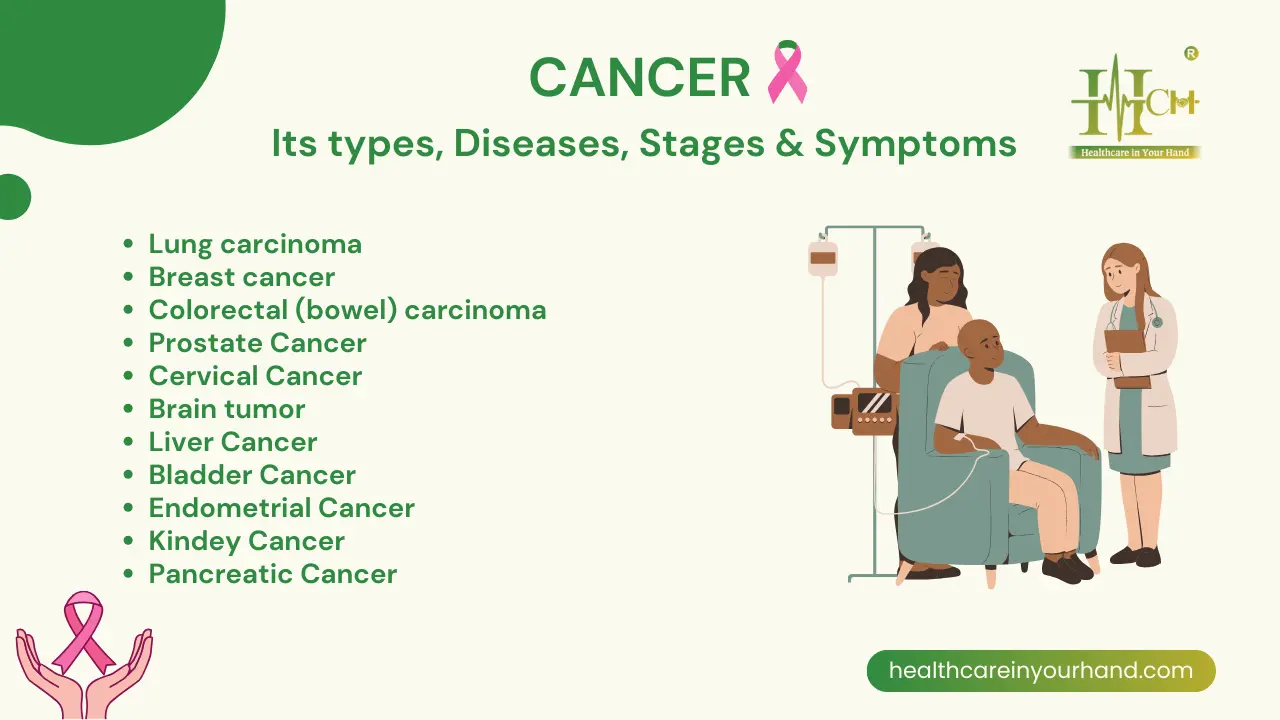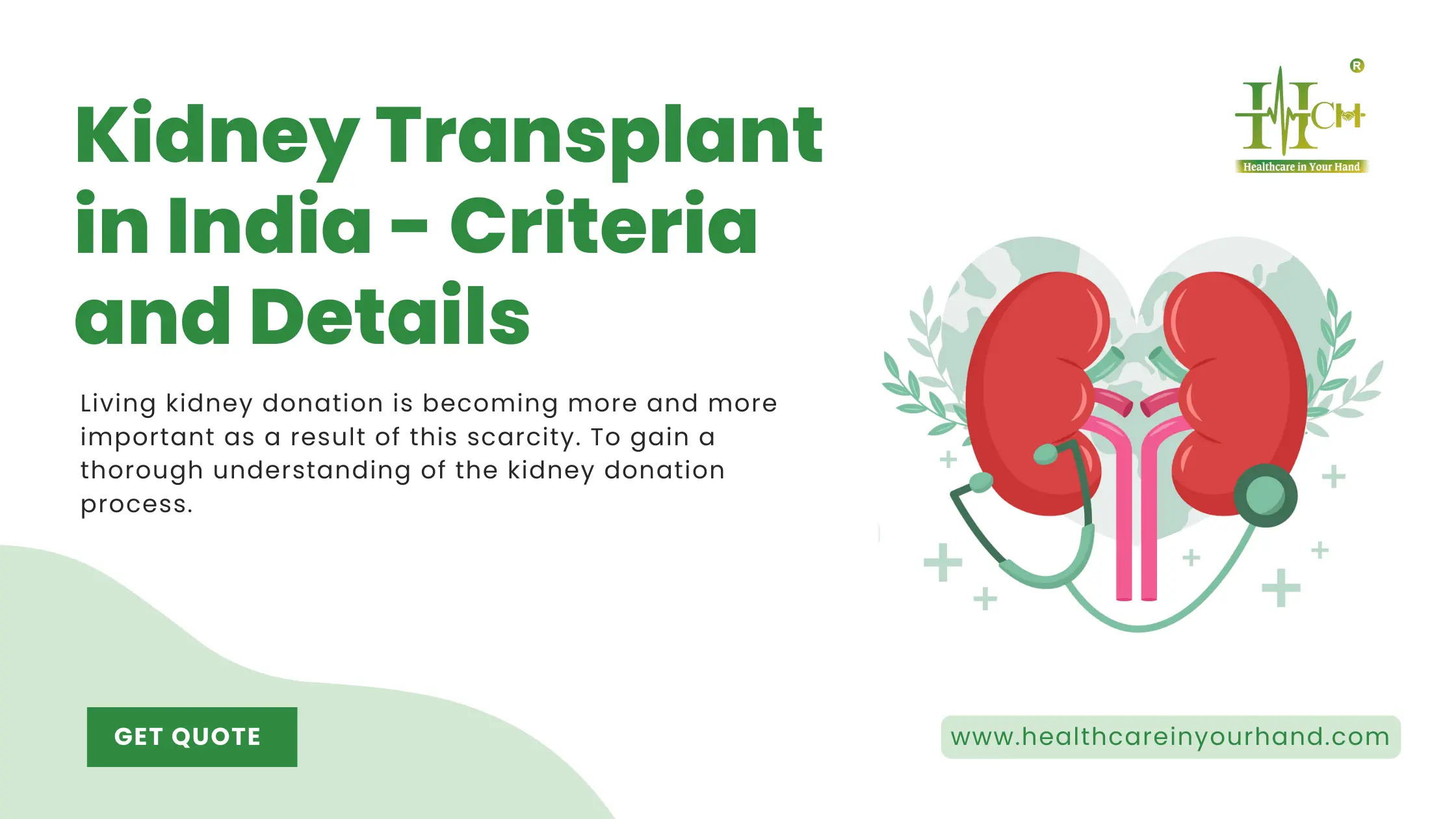Cancer, Its types, Disease, Stages & Symptoms
- 25 Oct, 2023
- 739
- Medical tourism
Cancer, Its
types, Disease, Stages & Symptoms
Cancer occurs when some of the body's cells grow out of control and
invade other bodily organs. The trillions of cells that make up the human body
are capable of developing cancer almost anywhere.
Gene instructions are frequently carried out by cells. Gene-set rules,
such as when to start and stop developing, must be followed by cells. Cancerous
cells break this rule of regulated proliferation & multiplication that
governs normal cells. Cancer involves uncontrolled cell development. Normal
cells experience apoptosis or programmed cell death. Cancerous cells ignore
these directives. Also, compared to healthy cells, cancerous cells multiply
more quickly.
Malignant tumors are an alternative term for cancerous tumors, which can
metastasize or spread to distant regions of the body to create new
tumors. Whereas, Benign tumors do not penetrate or spread to surrounding
tissues. When removed, benign tumors typically don't come back, although
cancerous tumors can.
There are numerous distinct forms of cancer, and each type also includes
subgroups that doctors may choose to treat differently. The following
categories are used to classify cancers:
1-
Carcinomas: These are the most
typical varieties. Epithelial cells, which cover the body's interior and
exterior surfaces, create them. The following categories can be used to further
break down carcinomas:
• Mucus or
fluid-producing epithelial cells are where adenocarcinomas grow. Adeno
carcinomas are the cancer types that affect the breast, colon, and prostate.
• Just beneath
the skin's surface, epithelial cells give rise to squamous cell carcinomas.
Organs including the intestines, stomach, bladder, lungs, and kidneys are also
lined with squamous cells.
2-
Sarcomas: Sarcomas develop in the body's soft tissues and bones. A typical kind
of bone cancer is osteosarcoma. Kaposi sarcomas, liposarcomas, and other
soft-tissue sarcomas are examples.
3-
Lymphomas:
Lymphomas are malignancies that arise from healthy lymphocytes, which are
immune system-related white blood cells that fight infections. The two primary
kinds of lymphoma are Hodgkin and non-Hodgkin.
4-
Leukemia: Leukemias are cancers that start in the blood-forming cells. They often
develop in the blood and bone marrow, not as malignancies.
5-
Melanomas: The melanocytes, which are responsible for your skin's color, are where
these malignancies start. Melanomas typically develop on the skin, though they
can sometimes appear elsewhere, like in the eye.
6-
Multiple Myelomas: A form of blood cancer called multiple myeloma develops from plasma
cells, an immune cell.
7-
Brain and spinal cord
cancers: These tumors develop in the body's neurological
system.
8-
Germ Cell Tumors: Your body's reproductive cells (egg or sperm) are the source of germ
cell cancers.
9-
Neuroendocrine Tumors: These grow in the hormone-releasing cells in your body.
10-
Carcinoid tumors: These neuroendocrine tumors are typically detected in the small
intestine and rectum.
The main types of cancer affecting body organs are:
A-
Lung carcinoma: Smokers are more likely to develop lung cancer, the most prevalent type
of cancer that starts in the lungs. The two main kinds of lung cancer are small
cell and non-small cell. Lung cancer can be brought on by smoking, exposure to
chemicals, secondhand smoke, and family history. The aberrant and
uncontrollable growth of lung wall cells causes it to happen.
Symptoms:
• Coughing that
worsens or doesn't go away.
• Pain in the chest.
• Pain in the chest,
back, or shoulders that is worse by coughing, laughing, or breathing deeply.
• Hoarseness or
wheezing.
• Appetite loss.
• Bloody cough etc.
B-
Breast cancer: Although breast cancer can affect either men or women, it is more
frequently found in women. It happens because of the breast tissue's enlarged,
clumped-together state brought on by abnormal cell development. sadly, this
malignancy will eventually be discovered in 1 in 8 females.
Some typical early
warning symptoms of breast cancer are:
• Sore breasts
• Changes in touch
(feel hard, warm, or tender)
• Nipple skin that is
peeling or flaking
• Nodes or lumps felt
inside or on the breast.
• an alteration in the
breasts' size or shape
• discharge from the
nipple other than breast milk, etc.
C-
Colorectal (bowel)
carcinoma: Every year, one to two million new cases of
colorectal cancer (CRC) are discovered, making it one of the most prevalent
diseases in the world. This cancer originates in the rectum or colon lining.
• Stool or rectal
bleeding.
• Constant abdominal
pain, cramps, or gas.
• Tiredness or a lack
of strength.
• Weight loss that
happens naturally, etc.
D-
Prostate Cancer: With 1,276,106 documented cases and 358,989 fatalities, prostate cancer
ranks second among all male cancers in the world. It develops from the cells
that border a section of the entire prostate gland. These symptoms are listed below.
• Difficulty getting
started urinating.
• Difficulty entirely
emptying the bladder.
• Semen or urine
containing blood.
• back, hip, or pelvic
pain that doesn't go away.
• A painful erection,
etc.
E-
Cervical Cancer: The cervix's aberrant cell proliferation is what leads to cervical
cancer. Cervical cancer is the most common cancer in women
worldwide. Cervical cancer alterations rarely lead to symptoms. A cervical
screening test is the only technique to determine whether there are cells that
are atypical that could turn cancerous.
The most typical
symptoms of cervical cancer include:
• Periodic vaginal
bleeding
• abnormally heavy or
prolonged menstrual bleeding
• bleeding following
sex, etc.
F-
Brain tumor: A brain tumor is a mass or collection of abnormal cells in the brain.
Your skull, which houses your brain, is quite rigid. Any expansion within such a constrained area can lead to issues.
Brain tumors may be benign or malignant (cancerous). The pressure inside
your skull may rise as benign or malignant tumors enlarge. It may be fatal and
may result in brain damage.
A brain tumor
frequently causes headaches. You might experience headaches that are worse in
the morning, while you sleep, or that worsen with coughing, sneezing, or
physical activity.
G-
Liver Cancer: The condition known as liver cancer is characterized
by uncontrolled liver cell growth. Both primary and secondary spreads can
originate in the liver. Hepatocellular carcinoma, a primary liver cancer that
starts in the major kind of liver cell, is the most prevalent form of the
disease. The most dangerous malignancies in adults are those of the liver.
Liver cancer symptoms include progressive weight loss; loss of
appetite; stomach discomfort; vomiting; weakness; fatigue; enlarged liver;
yellowing of the skin; white stools; and abdominal distension brought on by
fluid retention.
H- Bladder Cancer:
Bladder cancer is a common
type of cancer that begins in the cells of the bladder. Bladder cancer often
starts in the urothelial cells that line the interior of your bladder. The
majority of bladder cancer cases are found when they are still largely
treatable. However, bladder tumors of any stage might return following a
successful course of treatment.
Some signs of bladder cancer are urinary blood, difficulty urinating, back discomfort, Loss of appetite and rapid weight
loss, foot swelling, extreme sluggishness, and fatigue.
I-
Endometrial
Cancer:
Endometrial cancer develops from the endometrium,
which lines the uterus or womb. Cells that have the potential to infiltrate or
disseminate to other sections of the body are the cause of its aberrant cell
proliferation. Vaginal bleeding that is not related to a menstrual period is
frequently the first symptom. Other signs include pain when urinating, abnormal
discharge, discomfort during sexual activity, or pelvic pain. Most frequently,
endometrial cancer develops after menopause.
J-
Kidney Cancer:
Cells in your kidney tissue proliferate
uncontrollably, resulting in kidney cancer. These cells grow into a mass known
as a tumor over time. When a cell undergoes a change as a result of an external
stimulus, the development of cancer follows. Malignant tumors have the
potential to spread to other tissues and essential organs.
Blood in the urine, sudden weight loss, a lump in the
abdomen, lower back pain, fever, and appetite loss are some of the signs of
kidney cancer.
K-
Pancreatic
Cancer:
Pancreatic cancer develops when cells in the pancreas start to grow
uncontrollably and form a tumor. These malignant cells have the capacity to
colonize organs close to the pancreas.
Asymptomatic pancreatic cancer may be seen in its
early stages. Only when the illness worsens will symptoms emerge, which include
digestive issues, such as unusual feces, nausea, or vomiting, Back and upper
abdominal pain, lack of appetite, sudden weight loss, Jaundice, and elevated sugar
levels in diabetic patients.
Stages of Cancer
Preventing Cancer
Stage - Early diagnosis is the key to preventing cancer. Early detection of
cancer increases the likelihood that therapy will be successful.
Stage I or Invasion
Stage: The cancer has started to connect with neighboring tissues. This
suggests that it is no longer limited to a certain body part.
Metastatic Stage: The cancer
has spread past its original site. It may have spread to many body tissues or
organs.
Advanced Stage: The cancer
has advanced to the point where normal treatments including chemotherapy,
radiation therapy, and surgery are no longer effective.
Regression/Recurrence Stage: Some tumors might
eventually come back and cause death, even after therapy.
Tips to Prevent Cancer
Combining a healthy
lifestyle with routine screening could prevent at least one-third and possibly
more than half of all malignancies. This position statement summarizes the
research on the relationship between seven modifiable lifestyle variables and
the risk of developing cancer. Seven behaviors for adults are advised by
oncologists to lower their risk of cancer based on the evidence currently
available:
·
Avoid smoking
·
Keep a healthy weight.
·
Be active Consume a balanced diet and avoid drinking
too much alcohol
·
Be sun-wise.
·
Boost safety and infection defense, etc.
If somebody experiences the symptoms mentioned above and gets diagnosed with some type of cancer following
several tests, one should seek medical intervention immediately by consulting a specialized Oncologist. There are numerous specialized oncology hospitals
operating all over the world that offer top-notch care for a particular type
and class of cancer. Numerous such cancer surgery centers have earned the title
of best oncology hospitals or best cancer hospitals as a result of their
high success rate. You can research and choose which specialist or hospital to
contact using the abundance of information available online.







